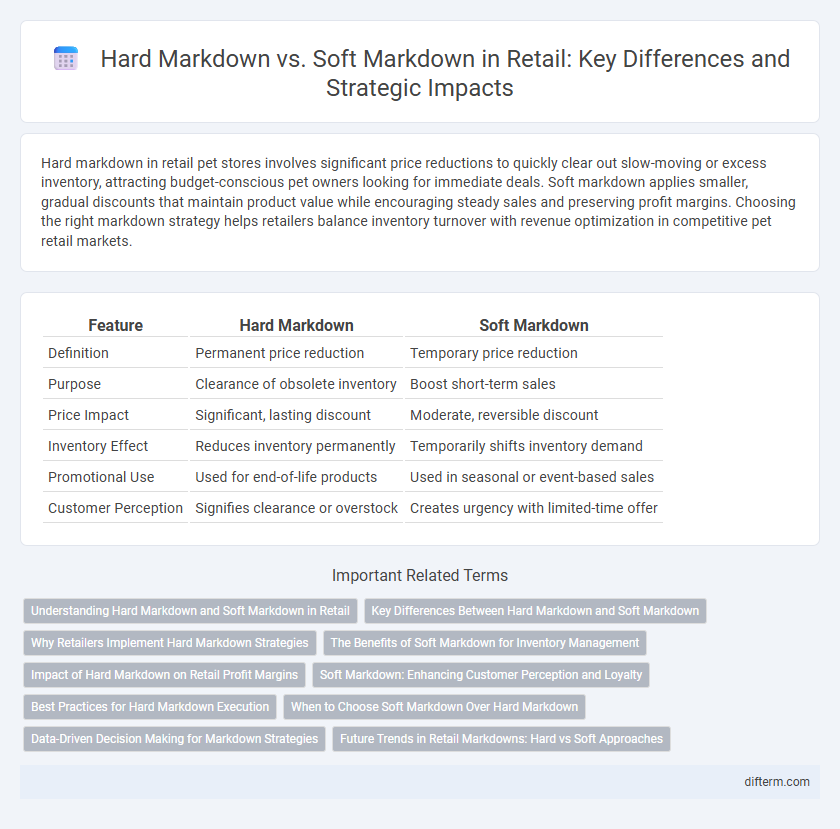Hard markdown in retail pet stores involves significant price reductions to quickly clear out slow-moving or excess inventory, attracting budget-conscious pet owners looking for immediate deals. Soft markdown applies smaller, gradual discounts that maintain product value while encouraging steady sales and preserving profit margins. Choosing the right markdown strategy helps retailers balance inventory turnover with revenue optimization in competitive pet retail markets.
Table of Comparison
| Feature | Hard Markdown | Soft Markdown |
|---|---|---|
| Definition | Permanent price reduction | Temporary price reduction |
| Purpose | Clearance of obsolete inventory | Boost short-term sales |
| Price Impact | Significant, lasting discount | Moderate, reversible discount |
| Inventory Effect | Reduces inventory permanently | Temporarily shifts inventory demand |
| Promotional Use | Used for end-of-life products | Used in seasonal or event-based sales |
| Customer Perception | Signifies clearance or overstock | Creates urgency with limited-time offer |
Understanding Hard Markdown and Soft Markdown in Retail
Hard Markdown in retail involves a significant price reduction, often exceeding 30%, aimed at quickly clearing out excess or obsolete inventory to free up shelf space and improve cash flow. Soft Markdown refers to smaller price adjustments, generally under 30%, used strategically to boost sales velocity, maintain customer interest, or respond to competitive pricing without heavily impacting profit margins. Retailers must analyze sales data and inventory turnover rates to balance hard and soft markdowns effectively, optimizing revenue while managing stock levels.
Key Differences Between Hard Markdown and Soft Markdown
Hard markdown involves a significant price reduction, often 20% or more, used to clear out unsold inventory quickly, whereas soft markdowns are smaller price adjustments, typically under 20%, aimed at stimulating sales without heavily impacting profit margins. Hard markdowns are usually applied to slow-moving or seasonal items nearing the end of their lifecycle, while soft markdowns are more flexible and frequently used as promotional tools. Retailers employ hard markdowns to manage excess stock aggressively, and soft markdowns to maintain steady sales velocity and customer interest.
Why Retailers Implement Hard Markdown Strategies
Retailers implement hard markdown strategies to quickly clear out slow-moving or excess inventory, reducing holding costs and freeing up valuable shelf space for new products. Hard markdowns create a significant price drop that attracts bargain hunters, boosting short-term sales volume and increasing cash flow. This aggressive discounting helps retailers maintain inventory turnover rates, minimize losses from obsolete stock, and optimize overall profitability.
The Benefits of Soft Markdown for Inventory Management
Soft markdowns help retailers strategically reduce prices without significantly eroding profit margins, enabling better demand forecasting and inventory turnover. This approach minimizes stock obsolescence and improves cash flow by maintaining product appeal while gently adjusting pricing. Effective use of soft markdowns supports dynamic inventory management by balancing sales velocity and product lifecycle.
Impact of Hard Markdown on Retail Profit Margins
Hard markdowns significantly reduce product prices, leading to immediate revenue drops and compressed retail profit margins by eroding gross margins. Retailers applying hard markdowns often face inventory devaluation, increasing the risk of losses on unsold stock and compromising overall profitability. This aggressive price reduction strategy demands careful inventory management to balance cash flow needs against long-term margin sustainability.
Soft Markdown: Enhancing Customer Perception and Loyalty
Soft markdowns subtly adjust prices without slashing them deeply, preserving product value while increasing customer appeal. This pricing strategy enhances customer perception by maintaining quality expectations and encouraging repeat purchases. Implementing soft markdowns effectively can boost brand loyalty through perceived fairness and continuous engagement.
Best Practices for Hard Markdown Execution
Hard markdown execution in retail demands precise timing and data-driven decision-making to effectively clear excess inventory without eroding brand value. Employing real-time sales analytics and customer behavior insights ensures markdowns are applied selectively to products with diminishing demand, maximizing revenue recovery. Consistent coordination between merchandising, pricing, and marketing teams enhances the impact of hard markdown strategies while maintaining overall profitability.
When to Choose Soft Markdown Over Hard Markdown
Soft markdowns are ideal when retailers aim to clear slow-moving inventory without significantly eroding profit margins, often used during seasonal transitions or minor overstock situations. This pricing strategy helps maintain brand value and customer perception by offering subtle discounts rather than deep cuts typical of hard markdowns. Retailers should choose soft markdowns to stimulate sales gradually while preserving long-term profitability.
Data-Driven Decision Making for Markdown Strategies
Hard markdowns are steep price reductions implemented to clear excess inventory rapidly, often analyzed through sales velocity data and inventory turnover metrics to minimize losses. Soft markdowns involve smaller, incremental price adjustments guided by real-time demand signals and customer behavior analytics to sustain margin while boosting sales. Data-driven decision making leverages predictive analytics and historical sales patterns to optimize markdown timing and depth, maximizing profitability in retail markdown strategies.
Future Trends in Retail Markdowns: Hard vs Soft Approaches
Future retail markdown strategies emphasize the balance between hard and soft markdowns to optimize profit margins and inventory turnover. Hard markdowns deliver significant price cuts to clear excess stock quickly, whereas soft markdowns apply gradual discounts, preserving brand value and customer perception. Emerging technologies like AI-driven pricing and predictive analytics enable retailers to dynamically adjust markdown strategies, enhancing responsiveness to market demand and consumer behavior.
Hard Markdown vs Soft Markdown Infographic

 difterm.com
difterm.com